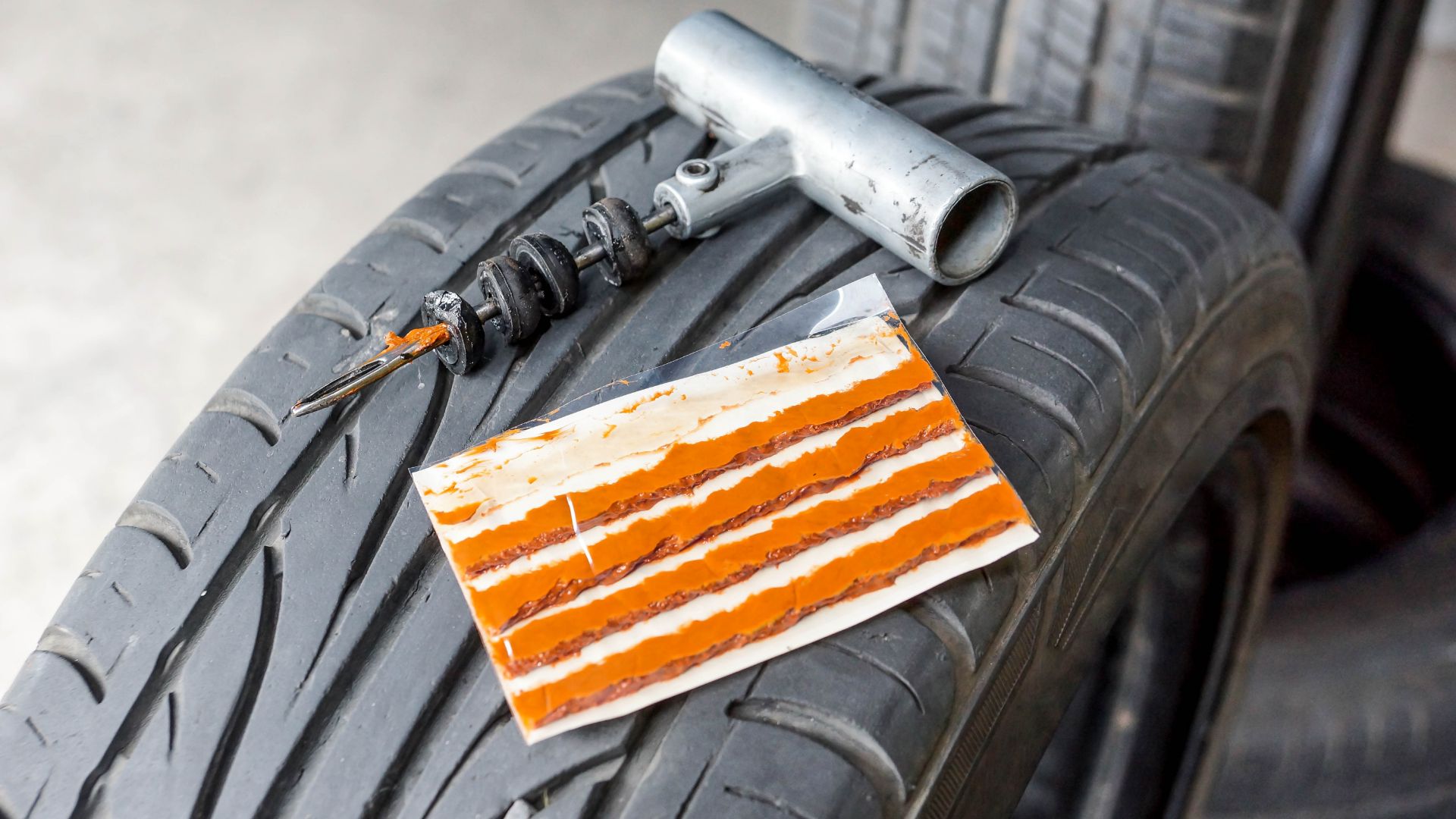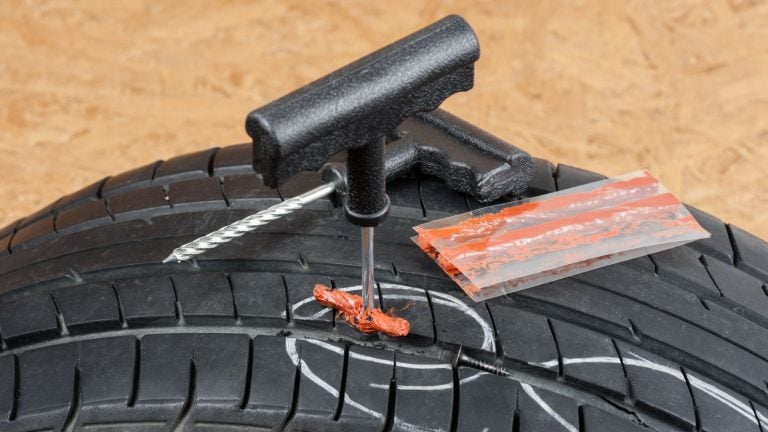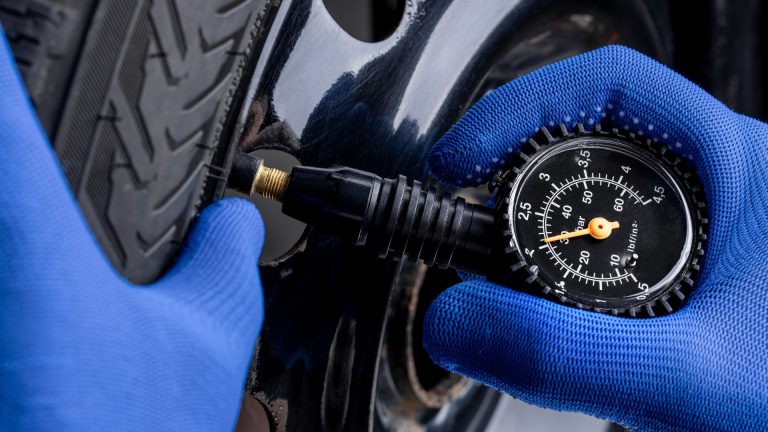How close to sidewall can a tire be patched?
Determine the optimal distance for tire patching near the sidewall.

A punctured tire is one of the issues you could have when driving. Nobody wants to be stranded on the side of the road because of a flat tire, but it does happen. You could be weighing your repair options because you want to get back on the road for as little money as possible. And a common way to get around this problem is by applying a patch.
However, the issue gets far more complicated if the hole is in a defensive position, such as a tire wall, as it is unlikely that you will be able to patch the defensive position.
So, how close to the sidewall can a tire be patched? The puncture must be at least 6 mm from the tire’s shoulder to fit a patch. In other words, if a crack is closer than 6 mm, there isn’t much you can do to fix it.
What is a tire sidewall?
Learning about sidewalls and how to recognize them on your tires comes first.
The rubber portion of the rim between the outside edge and the road surface is known as the wall. Additionally, this component has the most extensive area, is the most flexible, and continuously deforms when moving under loads. It’s also important to understand how tire sidewall damage can be serious and how it can endanger your traction and control over your vehicle.
The whole space between a tire’s tread and the bead is referred to as the sidewall. Important details regarding the tire are found on the sidewall, often known as the tire’s shoulder or sidewall. On the sidewall of each tire, the tire’s speed rating, load index, and tire size are imprinted by the manufacturer.
As the Falken Wildpeak A/T3W review suggests, some tires have reinforced sidewall treads, so the tire type is also something worth considering here.
What is a tire patch?
The tire patch is a piece of rubber with an adhesive backing. This side’s adhesive sticks to the inside of the tire and seals off the puncture. There’s often a misconception on the subject of tire plug vs patch and drivers using these two terms interchangeably.
Tire plugs can also be used to fix tire punctures. These plugs are strips of material with a rubber compound applied to them before being inserted into the hole. By securing the interior of the tire, this stopper will prevent air leakage.
The tire patch typically outperforms the tire plug in strength and dependability. However, applying a tire patch requires more effort than using a plug. Several tire shops employ a hybridized tire plug and patch design for better repair.
How do I properly patch a punctured tire?

The next step in repairing your punctured tire is to remove the tire from the wheel rim once the punctured area of the tire has been located. Plugging the holes is not a permanent repair nor a proper procedure. If the punctures are severe enough, the tires may need to be changed entirely. The punctures can be more thoroughly examined to ascertain whether the damage is minor or significant once the tire has been removed from the wheel rim.
If the puncture is repairable, it must be filed smoothly to stop it from spreading. For the patch to adhere adequately, you should also clean the area around the puncture on both sides of the tire. You can use an appropriate vulcanizing cement or a sturdy stem made of natural materials to fill the puncture hole after it has been prepared. Using vulcanizing cement rather than a solid stem has given us better results. You can apply the patch after the hole has been filled.
The patch is quite simple to apply, but different brands may have different instructions, so read them carefully before starting. You are now prepared to board another ride after the patching is finished. Remember that following a puncture, your tires aren’t in perfect condition. The tire won’t be able to handle the same pressure and speed after repair as it could previously. It will still offer the same level of handling and traction, though.
However, the rubber may stretch out and peel away from the rim when the tire becomes heated from driving quickly for extended periods or after the tire has been driven hard for several hours. This happens because the tire and rim expand and contract at various speeds, pulling the rubber from the rim.
What kind of tire damage can and cannot be repaired?
Small punctures that happen within an inch of the outermost margins of the inner steel belt can be repaired with puncture repair kits. The tires’ entire side wall and shoulder are regarded as structural components. Any repairs made to these regions render the tires useless if the puncture occurs more than one inch from the inner steel belt’s farthest margins.
Furthermore, anywhere in a tire’s tread area is susceptible to punctures. The hole cannot, however, be deeper than one-fourth inch. Any bigger holes necessitate replacing the entire tire. Additionally, the whole tire must be replaced if a cut or tear extends above one-fourth of an inset.
How do I avoid getting a puncture?

Although there is no foolproof way to prevent a puncture to a tire, there are certain easy precautions you may take to lower the likelihood of experiencing one. These are;
Check your tire pressure
Both for safety reasons and because they impact fuel efficiency, it’s crucial to keep tires inflated to the proper levels. A blowout can result from excessive tire air volume (TAC), which could be risky if not swiftly rectified. Gas mileage may be affected by a TAC that is too low. The likelihood of a tire puncture increases with increasing tire inflation as opposed to decreasing tire inflation. The inability to patch a punctured tire makes things worse, and the lack of a steel belt makes a punctured tire more vulnerable.
Furthermore, because tires are unable to dissipate heat, inadequate tire pressure can result in blowouts. Therefore, checking your tire pressure at least once a month is crucial to ensure it’s appropriate for your vehicle. Always remember that the recommended pressure is different from the one listed on the tire itself but rather the one listed on the door jamb stickers or in the owner’s manual.
Rotate your tires
You may be asking why we’d rotate our tires when they are already flat. It all depends on how much air pressure you put inside of them. Your tires get inflated when you fill them with air. Consequently, the wheel’s rubber rim is in contact with the ground.
Although there is no air between the two surfaces, the inside of the wheel does not touch the ground. It follows that the other side of the wheel can contact the ground if you remove and switch sides, and that’s why we refer to it as “rotating”.
Your tires’ rubber will wear unevenly and degrade more quickly in some places than others if you don’t rotate them. As a result, less rubber is lining the tire to prevent punctures, so you’ll probably sustain more damage from punctures than you would have if you’d rotated the tires.
Avoid bad roads
This is a relatively straightforward rule to adhere to. You simply need to avoid driving through any sizable obstructions on the road. Of course, you should avoid driving through anything that could harm your vehicle, but if you hit something you cannot see, your car could suffer damage.
Avoid overloading your tires
Overloading your car raises the risk of a puncture, much like increasing tire pressure. A blowout could also result from overloading.
The tires on your car are only designed to support a specific weight. This information can be located on the driver’s side door jamb or in the owner’s handbook.
If you exceed this weight, the tires may be under too much pressure. This extra weight causes the sidewall and tread of the tire to break down, which results in a puncture or blowout. Moreover, overloading your car is never a wise idea, no matter the circumstance.
Our take
If you wish to mend a flat tire, be sure the punctured portion falls inside the repairable area. Following that, you can choose between changing the tire or removing it to check it. The tires cannot be fixed if the puncture hole is less than half an inch in diameter or on the sidewall or shoulders. The tire’s sidewalls and shoulders are structural elements, and puncturing them would be dangerous.
Additionally, the tube cannot be repaired if the hole is large enough to penetrate the inner lining. Lastly, maintaining correct air pressure is the most excellent approach to avoiding flat tires.
How close can you patch a tire to the sidewall?
The puncture must be at least 6 mm from the tire’s shoulder to fit a patch. In other words, if a crack is closer than 6mm, there isn’t much you can do to fix it.
Can you patch a tire with a puncture to a sidewall?
No. It would be best to consider something other than patching or plugging a leak or hole in a sidewall. It is not advisable to undertake sidewall repair since it could endanger your safety on the road by compromising the tire’s integrity. A repair is more likely to fail because of the sidewall’s flexibility.
How long can you drive a patched tire?
A properly patched tire can last between eight months and a year. However, if you repeatedly patch your tire, the durability will decrease.u003cbru003eu003cbru003ePerformance and speed are never guaranteed, and you risk tire blowouts and car damage.